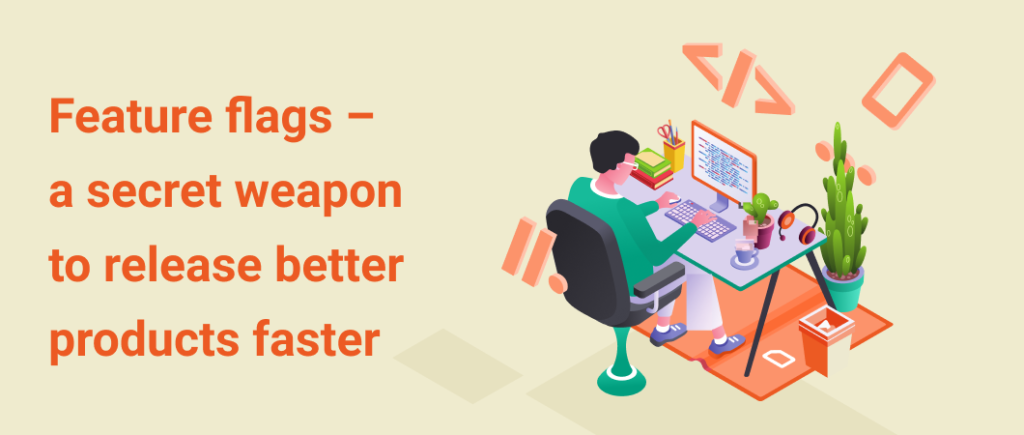Last updated on May 10th, 2024
As the connected world shifts faster towards digital technologies, it has opened the doors for mobile applications, software tools, and web applications to make an impact even in the enterprise.
In particular, this rapid move towards digital technologies is generating fierce competition among Software-as-a-Service (or SaaS) applications. Today’s users expect updated versions of their applications in a shorter turnaround time. Besides, they also want quicker bug fixes.
Continuous delivery and deployment of software applications with better features and updated versions ever faster is the focus now.
As developers roll out more product features or updates, how do they retain control to fix or roll back the feature without redeploying the entire code?
This is where feature flags can be effective. Let’s look at how feature flags work and how they can power up product development.
What are Feature Flags?
Simply put, feature flags are like toggles (or switches) that allow developers to enable (or disable) product features – without having to redeploy the new code. Feature flags empower developers with better control over updates, bug fixes, interface changes, or any new features. Among its benefits, feature flags enable lesser code rollbacks and quicker action on critical software bugs.
Depending on the needs, developers can configure multiple types of feature flags.
Types of Feature Flags
Depending upon their functionality, feature flags can be categorized into the following four major categories:
Feature Rollouts
Among the widely used types of feature flags, feature rollouts are used to gate the latest customer-facing product features. With the least access control, the developer team can use feature rollouts to ensure that the added feature has been completely rolled into the production environment (without any hitches). And application developers get complete control and visibility over feature rollouts.
Bug Fix
As the name suggests, the Bug Fix flag is used by developers to try and fix the critical bugs or to test them in the production environment. This type of flag needs to be removed once the bug has been fixed and tested. Like feature flags, the bug fix flags have the highest visibility and lowest access control.
Operational
Also known as the “circuit breaker,” operational flags are long-term flags that provide better control over the operational aspects of software products. For instance, developers can use operational flags to manually switch off (or disable) a feature or functionality. As they have a direct impact on the system behavior, the flagged functionality needs to be documented for users. As compared to feature rollouts and bug fix feature flags, operational flags have a higher level of access control with functionalities that are owned by the respective development team.
Permission
As the name suggests, permission feature flags determine which customer can have access to select product features (or not).
With the highest level of access control, permission flags can limit product features based on the pricing (or membership benefits) of the SaaS product plan selected by the consumer (or subscriber). For example, subscribers who use the free version of Spotify receive online ads and cannot listen to offline music. However, subscribers of the paid Spotify version can avail themselves of all its features. This is how permission feature flags work.
Besides these 4 feature flags, there are additional types of feature flags such as experiment feature flags, which are used based on specific development-related requirements.
Now that we know what feature flags are, let us see how feature flags can power up product development.
Benefits of Feature Flags that Accelerate Product Development
Feature flags have key benefits that help accelerate product development as discussed below:
Better control over new features
Among the most important benefits, feature flags offer developers better control over new features or enhancements. With feature flags, developers can now develop new features or enhancements (without going live or into production).
Effectively, feature flags empower application developers as they can determine when to “go live” with the added feature. Further, new product features can be thoroughly tested in the development environment for their expected functionality – before releasing them in the final production environment.
Faster product development
Effectively, feature flags, when combined with continuous delivery and integration (CI/CD) can accelerate product development. Software bugs, when found, can be fixed early, and rolled out (without any code redeployment).
Feature flags also save a lot of development effort as smaller code changes can now be easily merged into production instead of merging larger chunks of code changes that take time to be tested and merged. Finally, developers can also release software updates to the product in a comparatively shorter amount of time.
Better product improvements
Product improvements (based on user feedback) can come from multiple stakeholders including the product team, UI/UX team, or the testing team. With feature flags, product stakeholders can test and validate product-related “ideas” and be more involved in the development process.
By using the toggle switch, the product feedback can easily be integrated and tested with the product.
Better Risk mitigation
With more product control available to the developer, product features can be easily rolled back in the event of any major bug or negative feedback. This reduces “faulty” products being released with many bugs or issues.
In the long run, better and bug-free products can build brand reputation and customer loyalty.
Conclusion
In summary, feature flags have become a necessity in the world of SaaS-based product development where subscribers expect better features, faster updates, and quick resolution of product bugs. When used in moderation, feature flags can power up product development with all the benefits that we have discussed in this article.
Through its expertise in SaaS product development, Forgeahead has all the expertise needed to realize your product vision. Our range of services extends to DevOps, AWS Services, and mobile development.
Interested? Feel free to contact us to discuss further.



